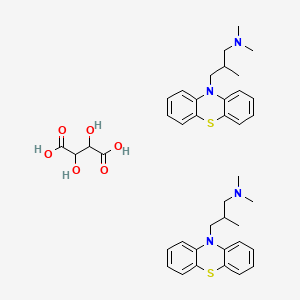



1. Temaril
2. Theralen
3. Theraline
4. Trimeprazine Tartrate
1. Trimeprazine Tartrate
2. 4330-99-8
3. Trimeprazine Hemitartrate Salt
4. Nsc-17475
5. Nsc-757358
6. Prestwick_144
7. Chembl3989885
8. Hms1570j05
9. Hms3714j05
10. Trimeprazine Hemi-(+)-tartrate Salt
11. Ccg-220842
| Molecular Weight | 747.0 g/mol |
|---|---|
| Molecular Formula | C40H50N4O6S2 |
| Hydrogen Bond Donor Count | 4 |
| Hydrogen Bond Acceptor Count | 12 |
| Rotatable Bond Count | 11 |
| Exact Mass | 746.31717767 g/mol |
| Monoisotopic Mass | 746.31717767 g/mol |
| Topological Polar Surface Area | 179 Ų |
| Heavy Atom Count | 52 |
| Formal Charge | 0 |
| Complexity | 445 |
| Isotope Atom Count | 0 |
| Defined Atom Stereocenter Count | 0 |
| Undefined Atom Stereocenter Count | 4 |
| Defined Bond Stereocenter Count | 0 |
| Undefined Bond Stereocenter Count | 0 |
| Covalently Bonded Unit Count | 3 |
Histamine H1 Antagonists
Drugs that selectively bind to but do not activate histamine H1 receptors, thereby blocking the actions of endogenous histamine. Included here are the classical antihistaminics that antagonize or prevent the action of histamine mainly in immediate hypersensitivity. They act in the bronchi, capillaries, and some other smooth muscles, and are used to prevent or allay motion sickness, seasonal rhinitis, and allergic dermatitis and to induce somnolence. The effects of blocking central nervous system H1 receptors are not as well understood. (See all compounds classified as Histamine H1 Antagonists.)
